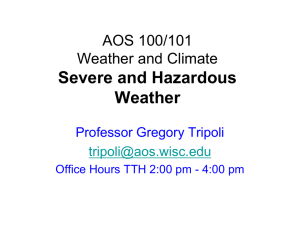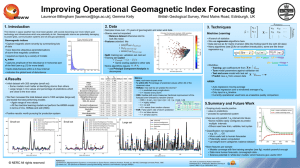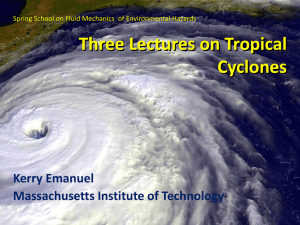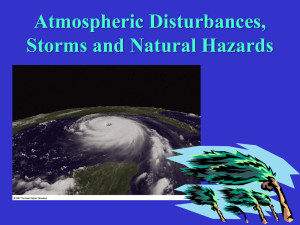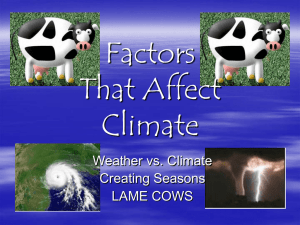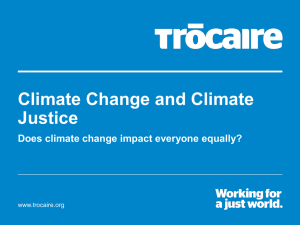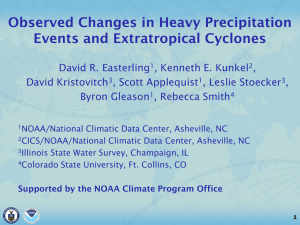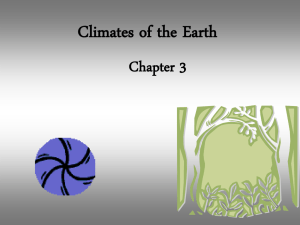High-resolution studies in NERC
advertisement
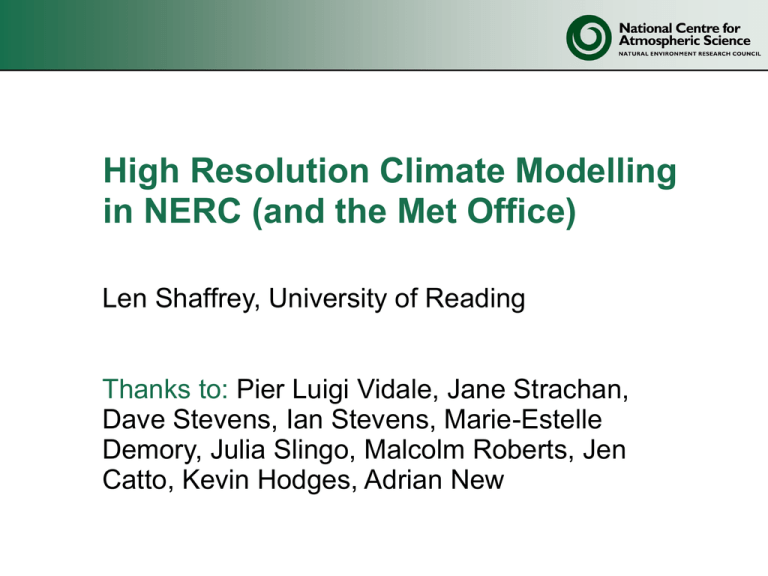
High Resolution Climate Modelling in NERC (and the Met Office) Len Shaffrey, University of Reading Thanks to: Pier Luigi Vidale, Jane Strachan, Dave Stevens, Ian Stevens, Marie-Estelle Demory, Julia Slingo, Malcolm Roberts, Jen Catto, Kevin Hodges, Adrian New High Resolution Climate Modelling HiGEM is based on the Met Office Hadley Centre coupled ocean-atmosphere climate model, HadGEM1 HiGEM was jointly developed by the National Centre for Atmospheric Science, the University of East Anglia, the National Oceanographic Centre and the Met Office HiGEM has an atmospheric resolution of 1.25ox0.83o longitude by latitude (90km), and 38 levels in the vertical The ocean resolution is 1/3ox1/3o, which allows the model to begin resolve ocean eddies (an eddy-permitting resolution). The ocean model has 40 levels in the vertical Centennial length runs have been integrated A 60km atmosphere-only model (NUGAM) has also been developed. Does increasing the resolution improve the representation of regional climate and weather? ENSO in HiGEM DJF El Nino SST Composites Observations HiGEM HadGEM Shaffrey et al. 2009, J. Clim. Tropical Instability Waves Instantaneous SSTs (lines) and surface windstress divergence (colours) from HadGEM1 (left) and from HiGEM (right) over the Tropical Pacific (Shaffrey et al. 2009, J. Clim.) The eddy heat transport convergence from Tropical Instability Waves warm the Tropical Pacific cold tongue, improving the mean state (Roberts et al. 2009, J. Clim.). Extratropical cyclones in HiGEM • Global climate models generate their own weather. This makes it difficult to evaluate weather systems in climate models • An emerging methodology is to evaluate the structure of extratropical cyclones using a compositing technique • Results will be shown from the HiGEM high-resolution global coupled climate model and the ERA-40 ECMWF global reanalysis. These have very similar horizontal resolutions (approx. 90km) •Catto, J. et al. 2010, Journal of Climate Creating composite structures for extreme storms in HiGEM and ERA-40 First work out the tracks of the strongest storms using the 850hPa vorticity and Kevin Hodges feature tracking program Creating composite structures for extreme storms in HiGEM and ERA-40 Then work out where the storms reach maximum strength (in this case maximum 850hPa vorticity) Creating composite structures for extreme storms in HiGEM and ERA-40 We then select the region around the these points.. Creating composite structures for extreme storms in HiGEM and ERA-40 We then select the region around the these points…and note which way they are moving Creating composite structures for extreme storms in HiGEM and ERA-40 We then select the region around the these points…and note which way they are moving Creating composite structures for extreme storms in HiGEM and ERA-40 Since the storms are all propagating in different directions we rotate the structures … Creating composite structures for extreme storms in HiGEM and ERA-40 Since the storms are all propagating in different directions we rotate the structures …and then average. + + = Storm Structure A A Propagation ERA-40 B HiGEM B Composites of system relative 925hPa wind speed (ms-1) from the 100 most intense NH wintertime storms Storm Structure ERA-40 HiGEM Composites of system relative winds and potential temperatures from the 100 most intense NH wintertime storms Storm Structure CCB CCB ERA-40 CCB = Cold Conveyor Belt HiGEM WCB = Warm Conveyor Belt Composites of system relative winds and potential temperatures from the 100 most intense NH wintertime storms Location of the simulated tropical storms Observed Track densities (storm transits/month) Northern Hemisphere High resolution Low resolution Modelled Courtesy of P-L. Vidale and Jane Strachan Intensity of simulated tropical storms Wind Speed near the surface Frequency Resolution V.Low Low Mid High (300km) (150km) (90km) (60km) Although high-resolution climate models are beginning to capture the geographical location of tropical storms, at these resolutions, we can’t capture intensity. Courtesy of P-L. Vidale and Jane Strachan Summary •Increasing resolution reduces some biases, and improves the representation of ENSO, blocking, NH stationary wave patterns and stratocumulus decks (Shaffrey et al. 2009, J. Clim.) •Higher resolution climate models are starting to resolve structures in weather systems, for example intense extratropical cyclones (Catto et al., 2010, J. Clim.). Can also simulate locations and number of Tropical Cyclones (although not intensity). •Increasing resolution is not a panacea. Major biases remain, e.g. both HadGEM1 and HiGEM poorly represent the distribution of Indian summer monsoon rainfall. Future Directions •The HiGEM and NUGAM models are being used extensively in a range of projects, VOCALS, Willis RN, Met Office PACE, Queensland CCE, etc... •Experimental decadal predictions using HiGEM are being produced for CMIP5. The results of CMIP5 will be used to inform the next IPCC assessment report (AR5) •NERC is involved in the development of the next generation Met Office high resolution coupled climate model, HadGEM3-H (Atmos: 60km; Ocean: NEMO ORCA0.25 grid) • Currently seeking funding from the NERC Storm Risk Mitigation programme to study the impact of climate change on extratropical cyclones • Consistent tracking diagnostics across the CMIP5 models • Using the ECMWF Athena results, investigate the impact of climate change on intense extratropical cyclones, and their upscale effects, in very high-resolution global atmospheric models A test: The 97/98 El Nino A test of the system, forecasting the 1997/1998 ENSO from Dec 1996. Timeseries of Nino3.4 SST anomalies from observations (black), the assimilation run (thick red) and three hindcasts (thin red).

